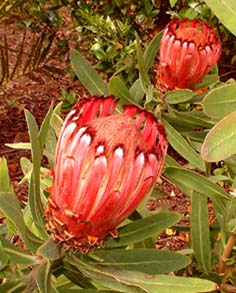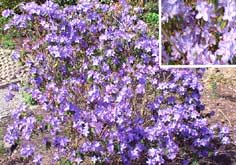Garden & Plants / Plants that grow well at Earlscliffe / Picture Gallery / 4 year pictorial study of plants / Plants in 2003
Previous / Next: Plants in 2002
Previous 'Plants of the month' 2003
Plant of the month for December, 2003
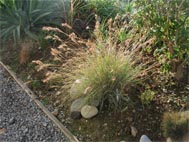 David
Robinson's family have chosen the December 'plant of the month'. This month it
is Cymbopogon validus. The name of this grass comes from the Greek kymbe,
meaning boat, and pogon meaning beard. It is a warm temperate plant normally
grown as ornamentals for foliage and for the light elegant flowering panicles.
David
Robinson's family have chosen the December 'plant of the month'. This month it
is Cymbopogon validus. The name of this grass comes from the Greek kymbe,
meaning boat, and pogon meaning beard. It is a warm temperate plant normally
grown as ornamentals for foliage and for the light elegant flowering panicles.
Plant of the month for November, 2003
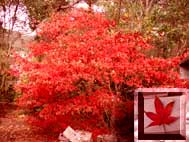 David
Robinson's family have chosen another 'plant of the month'. This month it is
Acer palmatum septemlobum 'Osakazuki'. Although this plant has been chosen
before (in 2001), this year it again put on a spectacular display in Autumn as
its green summer leaves turned to perhaps the most fiery scarlet autumn colour
of all the Japanese Maples. We were a little late in photographing the plant in
all its splendour, but the strength of the colour can still be seen.
David
Robinson's family have chosen another 'plant of the month'. This month it is
Acer palmatum septemlobum 'Osakazuki'. Although this plant has been chosen
before (in 2001), this year it again put on a spectacular display in Autumn as
its green summer leaves turned to perhaps the most fiery scarlet autumn colour
of all the Japanese Maples. We were a little late in photographing the plant in
all its splendour, but the strength of the colour can still be seen.
Plant of the month for October, 2003
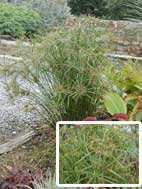 David Robinson's family have taken on the task of choosing a 'plant of the
month'. We have chosen this month what we believe is Cyperus alternifolius
(please mail us if incorrect). This plant is a native of the swamps of
Madagascar and is a relative of the papyrus of the Nile River. It survives best
in a tropical environment and would often be seen as a houseplant in more
northerly climates. This specimen started out as a houseplant, but was moved
outdoors around 8 years ago. It is surviving well, having lived through many
frosts over the years and is now around 1.5m tall. It loves wet conditions, so
our climate in Ireland is ideal!
David Robinson's family have taken on the task of choosing a 'plant of the
month'. We have chosen this month what we believe is Cyperus alternifolius
(please mail us if incorrect). This plant is a native of the swamps of
Madagascar and is a relative of the papyrus of the Nile River. It survives best
in a tropical environment and would often be seen as a houseplant in more
northerly climates. This specimen started out as a houseplant, but was moved
outdoors around 8 years ago. It is surviving well, having lived through many
frosts over the years and is now around 1.5m tall. It loves wet conditions, so
our climate in Ireland is ideal!
Plant of the month for September, 2003
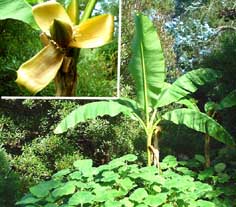 The
banana
(Musa basjoo) from the Ryukyu archipelago south of Japan is an easy plant to
grow at Earlscliffe. First planted in 1972 it has survived even the hardest
winters without protection . Its large soft leaves are easily damaged by the
wind and it often looks miserable during the winter, spring and early summer
months. It is at its best in the late summer, early autumn with its enormous
leaves, unusual flowers and small clusters of tiny green, inedible fruit. The
plant at the base is the hardy, large leaved Pelargonium papilionaceum
from South Africa and, in the background, a 5 metre high Dodonea viscosa
'Purpurea'.
The
banana
(Musa basjoo) from the Ryukyu archipelago south of Japan is an easy plant to
grow at Earlscliffe. First planted in 1972 it has survived even the hardest
winters without protection . Its large soft leaves are easily damaged by the
wind and it often looks miserable during the winter, spring and early summer
months. It is at its best in the late summer, early autumn with its enormous
leaves, unusual flowers and small clusters of tiny green, inedible fruit. The
plant at the base is the hardy, large leaved Pelargonium papilionaceum
from South Africa and, in the background, a 5 metre high Dodonea viscosa
'Purpurea'.
Plant of the month for August, 2003
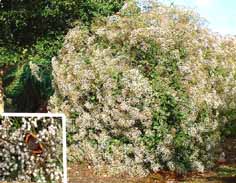 Eupatorium
ligustrinum, a native of Mexico, Guatemala and Costa Rica, is a useful late
flowering shrub with a haze of rose tinted flowers from August until November.
The flowers are pleasantly scented ànd are attractive to butterflies. This plant
has never shown any sign of low temperature injury even after the very cold
2000/01 winter.
Eupatorium
ligustrinum, a native of Mexico, Guatemala and Costa Rica, is a useful late
flowering shrub with a haze of rose tinted flowers from August until November.
The flowers are pleasantly scented ànd are attractive to butterflies. This plant
has never shown any sign of low temperature injury even after the very cold
2000/01 winter.
Plant of the month for July, 2003
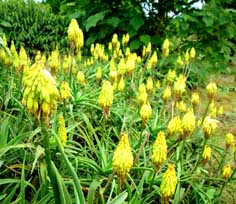 Aloe
striatula is the hardiest and most floriferous of a large number of Aloe
species tested at Earlcliffe. It has never shown any sign of weather damage
since planted 35 years ago, has survived -7.5°C and flowers
regularly. A. striatula is much hardier than A.vera but appears to
have many of the same medicinal qualities. It is one of the easiest of plants to
propagate here as branches stuck in the open ground root readily at any time of
the year.
Aloe
striatula is the hardiest and most floriferous of a large number of Aloe
species tested at Earlcliffe. It has never shown any sign of weather damage
since planted 35 years ago, has survived -7.5°C and flowers
regularly. A. striatula is much hardier than A.vera but appears to
have many of the same medicinal qualities. It is one of the easiest of plants to
propagate here as branches stuck in the open ground root readily at any time of
the year.
Plant of the month for June, 2003
Protea neriifolia growing in ordinary garden soil but in a well drained situation. My policy of not using fertiliser on trees and shrubs is useful for Protea spp as they are extremely sensitive to nitrates and phosphates. This plant was obtained in September 2000 as a small seedling and was planted outside in May 2001. The attractive goblet shaped blooms are about 12 cm long and the plant flowered for the first time in November 2002.
Plant of the month for May, 2003
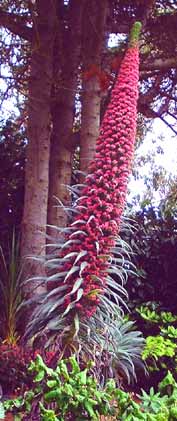 This
plant is one of many Echiums that self seed themselves prolifically around the
garden. It is 2.5 metres tall and is apparently a hybrid between Echium
wildpretii and E. pininana, being intermediate in height between its
two parents. This plant has inherited flower colour and density of inflorescence
from its female parent (E. wildpretii) but usually such hybrids are more
purple in colour. It is possible, therefore, that the male parent is an
Echium wildpretii x pininana hybrid rather than E. pininana.
Pure self sown seedlings of E. wildpretii also occur but do not normally
grow to a height of more than 1.6 metres.
This
plant is one of many Echiums that self seed themselves prolifically around the
garden. It is 2.5 metres tall and is apparently a hybrid between Echium
wildpretii and E. pininana, being intermediate in height between its
two parents. This plant has inherited flower colour and density of inflorescence
from its female parent (E. wildpretii) but usually such hybrids are more
purple in colour. It is possible, therefore, that the male parent is an
Echium wildpretii x pininana hybrid rather than E. pininana.
Pure self sown seedlings of E. wildpretii also occur but do not normally
grow to a height of more than 1.6 metres.
Plant of the month for April, 2003
Rhododendron 'Saint Breward' with its violet blue flowers provides a pleasant contrast in April to the warm colours of the Kurume azaleas, Camellias and Pieris. Saint Breward is a hybrid of R.augustinii.
Plant of the month for March, 2003
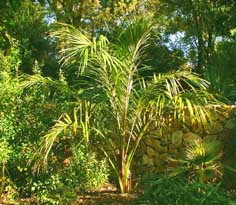 There
are many mysteries associated with this month’s little known plant, Juania
australis. It is not mentioned in the New RHS Dictionary of Gardening and
it has been described in Chamaerops, the Journal of the European Palm
Society, as ‘the Ungrowable Palm’. J. australis is native to the Juan
Fernández Islands situated at 33° S. It is a rare palm, endangered due to
habitat destruction. Export of seed from Juan Fernandez Islands has been banned
by the Chilean Government. It is on the IUCN
Red List of Threatened Species.
There
are many mysteries associated with this month’s little known plant, Juania
australis. It is not mentioned in the New RHS Dictionary of Gardening and
it has been described in Chamaerops, the Journal of the European Palm
Society, as ‘the Ungrowable Palm’. J. australis is native to the Juan
Fernández Islands situated at 33° S. It is a rare palm, endangered due to
habitat destruction. Export of seed from Juan Fernandez Islands has been banned
by the Chilean Government. It is on the IUCN
Red List of Threatened Species.
It was given to me as a young plantlet by Chris Bailes, Curator of the RHS’s Garden at Rosemoor, Devon in September 1995. His parting words were:- ‘It won’t grow outside with you, it doesn’t even survive at Tresco’. After planting it in the garden, the young plant experienced the exceptionally cold 1995/96 winter when the temperature fell to –7.5° C, the absolute minimum recorded at Earlscliffe since records began in 1969. This had no adverse effect on the young Juania and it has proved to be the fastest growing palm in the garden, requiring no attention since planting, apart from routine weed control with Roundup.
This palm should be more widely planted in coastal areas of Ireland but seed is difficult to obtain due to export ban. There is reputedly only one fruiting tree (in Chile) outside its native Juan Fernandez Islands. We would appreciate any information on possible seed sources.
Plant of the month for February, 2003
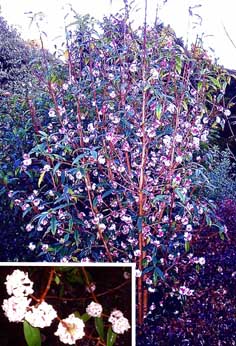 Daphne
bhuloa, from the Himalayas, is a superb winter-flowering shrub - good to
look at and even better to smell. It begins to flower in December and continues
until March, without showing any signs of frost or wind injury. Young flowers
are purplish pink in colour and become white as the flower ages. The main
attribute of Daphne bhuloa is the intense sweet fragrance from the flower
clusters which can be smelt over a large area on a calm day. With the advent of
micropropagation, it is now more readily available in garden centres .
Daphne
bhuloa, from the Himalayas, is a superb winter-flowering shrub - good to
look at and even better to smell. It begins to flower in December and continues
until March, without showing any signs of frost or wind injury. Young flowers
are purplish pink in colour and become white as the flower ages. The main
attribute of Daphne bhuloa is the intense sweet fragrance from the flower
clusters which can be smelt over a large area on a calm day. With the advent of
micropropagation, it is now more readily available in garden centres .
Plant of the month for January 2003
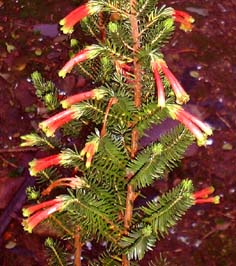 Erica versicolor is one of the numerous Cape Heaths that can do much to
provide interest and brighten up the garden during some of the darkest days of
the year. It is surprising that South African heathers are looking so well here
at present for they are reputed to dislike damp conditions and we have just had
one of the wettest autumns and early winters on record. Erica versicolor
is not as frost hardy here as many other Cape Heaths such as E.
canaliculata and E. pageana, but so far this winter the temperature
has not fallen below - 3 ° C and a number of young plants are looking very much
at home.
Erica versicolor is one of the numerous Cape Heaths that can do much to
provide interest and brighten up the garden during some of the darkest days of
the year. It is surprising that South African heathers are looking so well here
at present for they are reputed to dislike damp conditions and we have just had
one of the wettest autumns and early winters on record. Erica versicolor
is not as frost hardy here as many other Cape Heaths such as E.
canaliculata and E. pageana, but so far this winter the temperature
has not fallen below - 3 ° C and a number of young plants are looking very much
at home.
Plant Collections
For more details of the plants that grow at Earlscliffe, see the following pages
This page was last updated on 27-Jul-2023 .

